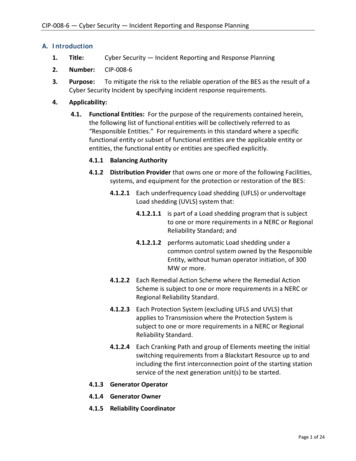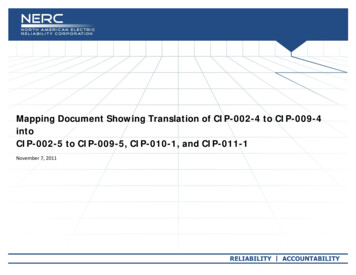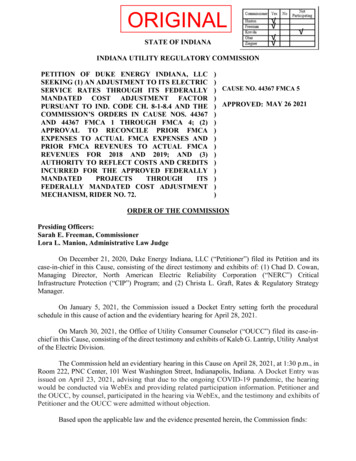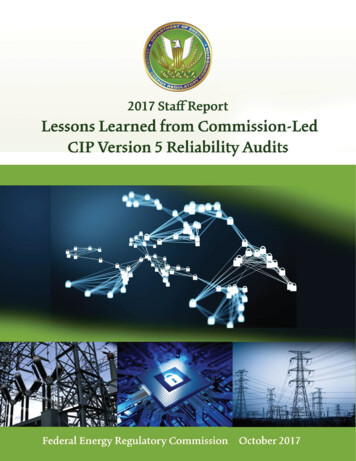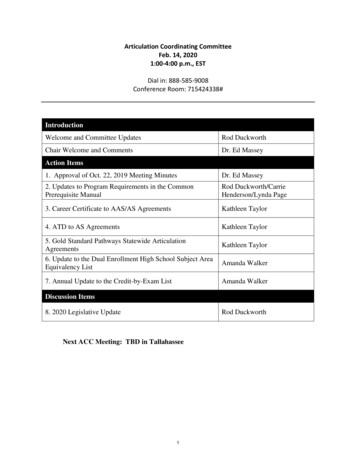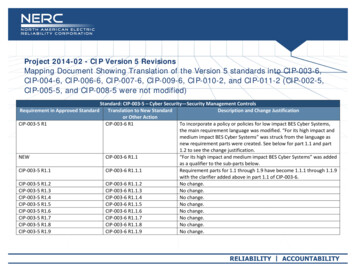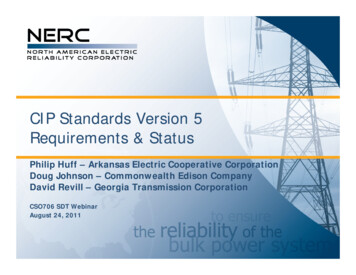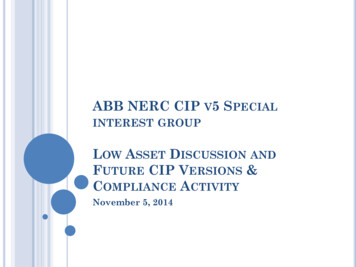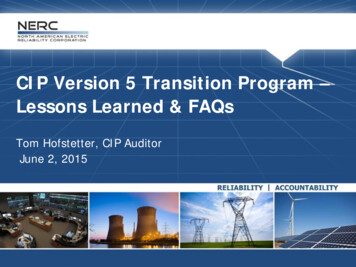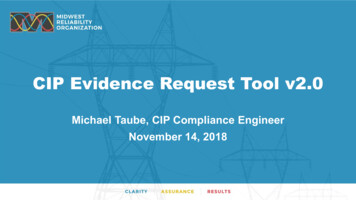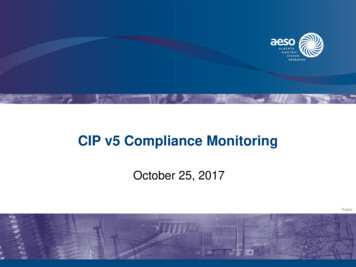
Transcription
CIP v5 Compliance MonitoringOctober 25, 2017Public
Welcome CIP Stakeholder Session AESO team– Daniela Cismaru, Jeff Norek, Chris Dittrick, Peter Wong Safety, Washrooms and LogisticsPublic2
Fire ProcedurePublic3
Logistics Session is booked from 9 am to noon– Will have one 15 minute break– Will cover the Agenda in a couple of slides Sign-in SheetPublic4
Purpose To provide understanding of the CIP compliance monitoringprogram and approach– Provides assurances to the industry that those involved inreliability and security are meeting the standards set out– What do you need to know to be ready to demonstrate you arecompliant– Not about how to be ‘technically compliant’, but how to show youare if you arePublic5
Update September 2015 – AUC approves set of CIP standards November 2016 stakeholder session– Provided the approach for monitoring CIP standards– Identified areas of concern, plans to address them through 2017 Submitting TFEs – what’s the process? Clarity around the use of NERC Guidance material Clarity around the IAC language Clarity around the CMPPublic6
Agenda Purpose and Objective CIP v5 Compliance Monitoring Approach Next Steps Q&APublic7
Purpose and Objective During the CIP v5 standards consultation we havecommitted to establish and bring to the market participantsthe approach used for monitoring CIP v5 compliance Provide an overview of the tools and processes as theyrelate to CIP v5 compliance evaluation Get your input and identify any concerns The end goal– CIP v5 compliance approach is well understood, effective, andefficient for the AESO and the market participantsPublic8
Compliance Monitoring Approach Compliance Monitoring Program– Tools, timelines, expectations (including informationmanagement)– Technical Feasibility Exceptions (TFE)– Identify, Assess and Correct (IAC) Supporting Documentation and Processes– Training and guiding documentation– AA (Applicability Assessment)– RFI (Request for Information, Waivers or Variances) Technical and Implementation Matters– IDs– CIP-PLANPublic9
Compliance Monitoring Approach - CMPFacts and considerations CIP v5 standards are new to the industry and the AESO Different degrees of understanding of standards content andintent High volume of requirements Significant number of requirements are technical vs.procedural NERC’s auditors qualifications and designationsPublic10
Compliance Monitoring Approach - CMPApproach Reviewed the current program for suitability Identified and evaluated options– Continue with the current approach– Increase reliance on spot audit, and self-certification– Change it all together Engaged market representatives to identify potential issuesand impact Assessed NERC’s CIP methodology Hired external expertise to support the technical and thecompliance reviews (AESI)Public11
Compliance Monitoring Approach – CMPOutcome The current Compliance Monitoring Program will be used forassessing companies’ compliance with CIP v5 standardsPublic12
Compliance Monitoring Approach – Audit Two types of audits – scheduled audit and spot check audit Selected option - Scheduled audit– Commence with Q1/2018 audits– Notifications – send 30 days in advance of the evidencesubmission date, except for the first group of auditedcompanies/mid-November– Scope - all CIP v5 requirements applicable to your company &subset of the power system– Duration of the audit – 3 months, except when High andMedium Impact assets are identified/extended up to 5 monthsPublic13
Compliance Monitoring Approach – Audit Processes, timelines and documentation– Submission of evidence – approx. 1 month after the audit enddate Q1 – early February Q2 – early May Q3 – early August Q4 – early November– Information Requests - response required within 2 or 5business days (clarification/missing information vs. sampling)– Audit reports Draft report – 10 business days to reply Final report - 10 business days after receiving your comments– Referrals – on the same day of issuing the Final audit reportPublic14
Compliance Monitoring Approach – Audit RSAWs– Developed in 2015 based on NERC RSAWs– Comprehensive review in 2017 Market’s inquiries and the lessons learned during the AESO’simplementation were considered Outcome - no changes to the RSAWs– Link to the external website - lic15
Compliance Monitoring Approach – Audit Submission of evidence - business as usual- Email, USB, mail delivery . Good old times .Public16
Compliance Monitoring Approach – AuditInformation Management Information Management– Currently managed in accordance to ISO Rules 103.12 and103.1, meaning that all information obtained, created orexchanged during an audit must be handled withconfidentiality– CIP011 “Cyber Security Information - Information Protection”triggered a comprehensive review of existing processes andpracticesPublic17
Compliance Monitoring Approach – AuditInformation Management Scenario 1: CIP-011 applies to your company– A new information exchange mechanism in place Scenario 2: CIP-011 does not apply to your company– The new information exchange mechanism is optionalInformation ExchangeInternal ManagementPublic18
Compliance Monitoring Approach – AuditInformation Management Information Exchange– Pertains to Evidence received by the AESO IRs (issued and responses) Audit reports Referrals Any information required by the MSA after the submission of thereferral (Note: it may be used as the cc mechanism of the selfreports)– Solution developed by the AESO with input from market’srepresentatives– Training will be provided in advance of the auditPublic19
Compliance Monitoring Approach – AuditInformation Management Internal management of information– Pertains to all information obtained, created or exchangedduring the audit Self-Reports Evidence received by the AESO IRs (issued and responses) Completed RSAWs Auditors’ notes Internal decisions summaries Audit reports Meeting notes ReferralsPublic20
Compliance Monitoring Approach – AuditInformation ExchangeSolution: SharePoint Online File Sharing AESO Security Assessment– Thorough assessment of vulnerabilities, threats, impacts andrisks to SharePoint Online services– Review and assessment of Microsoft SOC 2 report– NDA with Microsoft covers all data in AESO tenant Data & Storage– All data stored in Canadian data centres (primary and backup)– Encryption At Rest: BitLocker with AES 256-bit encryption onservers– Encryption In Transit: TLS/SSL with client machinesPublic21
Compliance Monitoring Approach – AuditInformation Exchange Security Controls– 2-Factor authentication activated on all AESO accounts– Complex password requirements– Access to information further controlled with SharePoint site levelpermissions groups, company data and access alwayssegregated at site level– Ability to access user data disabled– Each market participant is responsible for managing their users’login securityPublic22
Compliance Monitoring Approach – AuditInformation Exchange Secure Processes– All permissions changes follow strict procedural control– Permissions changes performed by Application Administrators– Limited exposure: information uploaded to SharePoint isdownloaded and deleted, never left online for extended periodsof time Access to Information– ARS Compliance Team– SOs/SMEs/MSA based on need; assessment done by Manager– Application Administrators Audit & Logging– All activities in O365 are logged and are auditablePublic23
Compliance Monitoring Approach – AuditInternal Management of InformationOverview AESO Information Security Program– Information Security Program– Information Classification Scheme AESO’s CIP Program (specific to information protection)– AESO CIP-011 Practice– AESO CIP-004 Practice Handling Market Participant (MP) Information24
Compliance Monitoring Approach – AuditInternal Management of Information AESO Information Security Program– AESO Information Classification Scheme Public AESO Internal AESO Protected AESO Protected CIP– Information Classification establishes the basis on whichsecurity controls are applied to given information25
Compliance Monitoring Approach – AuditInternal Management of InformationAESO’s CIP Program Structure (AESO Protected CIP)– CIP Cyber Security Policy– 10 Standards each with accountable Standard Owner– Each Standard has defined and formally accepted Internal BusinessPractices (IBPs)– CIP-011 Practice R1: Identify Mark Store (Designated Storage Location - DSL) DSL list is maintained by the Corporate Security Team R2: Information Handling: Information Security Standard defines how AESOProtected CIP information will be handled and protected through it’s lifecycle– CIP-004 Practice DSL links both CIP-011 and-CIP 004 standards CIP-004 uses DSL to monitor and report on access management to locationsidentified in the DSL list26
Compliance Monitoring Approach – AuditInternal Management of Information Handling Market Participant (MP) Information– MP information is marked as AESO Protected CIP– All security controls associated with AESO Protected CIP areafforded to MP’s information– Subject to WECC audit– Independent attestation on AESO’s Security Controls27
Compliance Monitoring Approach – Audit Mid-2018 the AESO will perform a comprehensive review ofthe Q1 and Q2/2018 audits performance and make changesif necessary– Pilot approach– Evaluate internal and external preparedness (focus ofevidence)– Alignment on understanding the standards (wording, intent)– # of IRs and quality of the repliesPublic28
Audit Statistics – as of September 201729
Compliance Monitoring Approach –Self-Certification Status quo Annual self-certification required on all applicablerequirements Letters submitted via emails or USBs Sharepoint Online access provided if the technicalassessment of the self-certification letter pertains to orrequires BCSI30
Compliance Monitoring Approach - TFE “where technically feasible” term referenced in some CIP v5requirements CIP-SUPP-002 – allows for submission and approval ordisapproval of Technical Feasibility Exceptions (TFE) ID #2016-005RS includes– Criteria for approval– Request form– Submission, Review, Approval and Amendment processes TFE process is not a compliance process All information pertaining to a TFE is treated as “AESO CIPProtected”Public31
Compliance Monitoring Approach - TFE Compliance assessment of approved TFEs– Up to the date of the TFE approval, in accordance to therequirement– After the TFE approval, in accordance to the TFE’s conditions– If found in contravention, the approved TFE will be provided tothe MSA for referencePublic32
Compliance Monitoring Approach – IAC “identifies, assesses and corrects” term used in a subset ofCIP v5 requirements Section 5 of ID #2015-003RS clarifies:– The language is going to be removed from future versions ofthe CIP standards– In the meantime, reliance on the self-report, with focus on themitigation planPublic33
Compliance Monitoring Approach – IAC Compliance expectations– Evidence that the market participant is able to identifydeficiencies in meeting the technical part of the requirement– Records of each identified deficiency in meeting the technicalpart of the requirement– Records of the result of an assessment made of eachidentified deficiency in meeting the technical part of therequirement– Records of the mitigating actions made to correct eachidentified deficiency in meeting the technical part of therequirements– Evidence that each identified deficiency in meeting thetechnical part of the requirement was correctedPublic34
Supporting Documentation and Processes Compliance processes training– Available to market’s representatives– Targeted audience are the Compliance representatives, but itcould be beneficial to SOs/SMEs– Provided a few days after the Audit or Self-Certificationnotifications are issued– On-line training provided on the external website blic35
Supporting Documentation and Processes Documentation and guides– Posted externally - � No updates were viewed as necessaryPublic36
Supporting Documentation and Processes Applicability Assessment (AA)– Requests could be made for assessing applicability of: Functional Entity Reliability Standard Requirement Facility, generating unit– While AA is not a Compliance process, rscompliance@aeso.caused to receive request and communicate assessments– Observations: AA is not meant to support confirmation of non-applicability CIP-002/R2.12 - each control centre or backup control centre used toperform the functional obligations of the operator of a transmissionfacility (transmission facilities at 2 or more locations)Public37
Supporting Documentation and Processes Request for Information, Waivers or Variance (RFI)– Requests to be sent at RFI@aeso.ca– This is not a Compliance process– Assessment could result in an ID being issued or updated(compliance evaluation takes the IDs into considerations)Public38
Technical & Implementation Matters New CIP ARS Terms and Definitions– Referenced on the landing page off all CIP v5 standards ID #2015-003RS– Section 2 – Use of NERC Guidance Information for the CIPStandards #2016-006RS– Radial Circuit CIP-PLAN– Most of the requirements in effect as of October 1, 2017– Exceptions referenced in the CIP-PlanPublic39
Next Steps Audit Notifications– For Q1/2018 - mid-November 2017 Audit training– Provided by the AESO - late November/early December 2017– On-line training Self-Certification notifications– Cycle 4, 2017 – October 31, 2017 Self-Certification training– November 29, 2017 SharePoint Online training– January 2018; future communication to work on the detailsPublic40
Next Steps Questions, concerns, issues pertaining to CMP, training,documentation: rscompliance@aeso.ca– We are committed to a timely response– Provide details, reasons, impact, constrains Feedback opportunityPublic41
Q&APublic42
Thank You!Public
- Referenced on the landing page off all CIP v5 standards ID #2015-003RS - Section 2 - Use of NERC Guidance Information for the CIP Standards #2016-006RS - Radial Circuit CIP-PLAN - Most of the requirements in effect as of October 1, 2017 - Exceptions referenced in the CIP-Plan . Public . 39
